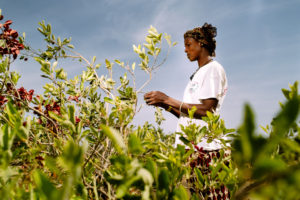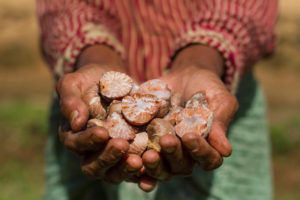
When Professor Katherine Gibson opened the Seeds of Change conference in Canberra last week, she asked the more than 200 participants to consider whether we are sowing the right seeds of change for achieving gender equality in agricultural development.
“Can the world’s rural areas be places where we can generate dignified agricultural livelihoods, where there’s material well-being, where there’s gender equity and sustainable environmental interactions?” she inquired.
Her questions were prompted by a series of graphs, known as ‘the great acceleration’, that show the world’s economic overdevelopment and its detrimental impacts on the environment. However, Gibson was quick to point out that the great acceleration has also brought about benefits, with some of the most prominent being increased education for women and slowed population growth.
“We really need to see the complexity here,” Gibson explained in a subsequent interview, referencing these contradictory results of recent development. Development and its gendered impacts are complex matters – a realization that permeated discussions during the three-day conference.
Convened by the Australian Centre for International Agricultural Research (ACIAR), the CGIAR Collaborative Platform for Gender Research and the University of Canberra, the Seeds of Change conference brought together researchers and practitioners from around the globe. The CGIAR Research Program on Forests, Trees and Agroforestry (FTA) contributed to the deliberations with three presenters showcasing studies that emphasize the importance of understanding complex gender relations for designing successful policies and interventions.
Read also: Women improve food security through land-restoration technology in Kenya

Examining evidence
Kartika Sari Juniwaty, lecturer at the University of Indonesia’s Faculty of Economics and Business and research associate at the Centre for International Forestry Research (CIFOR), presented initial research findings that highlight why challenging generally accepted beliefs about women and agriculture is a good starting point.
“There is an underlying belief that feminization of agriculture happens in this one way – that men are leaving the sector and women are taking over. But in reality, it is much more complicated than that,” Juniwaty said.
Examining 20 years of longitudinal data, collected from more than 7,000 households in Indonesia since 1993, Juniwaty has found that while fewer and fewer people are employed in agriculture, men are not leaving the sector at a faster rate than women. This differs from the situation elsewhere, such as in some parts of South Asia, where men are migrating out of villages and leaving the agricultural sector. In addition, families seem to have left and reentered the agriculture sector many times during the 20-year period, raising questions about what drives such decisions.
Juniwaty stressed that policies and interventions must be informed by on-the-ground realities to be successful. Improved understanding of gendered transformations may better inform the design of policies, such as the Indonesian government’s social forestry program, which gives communities rights to sustainably use forests to boost their livelihoods and incomes.
“We might think that a program can be more beneficial for women if they are given more opportunity to participate,” explained Juniwaty. “But to design appropriate initiatives to encourage women’s participation in the program, improve their well-being, and avoid unintended negative consequences, we need to better understand women’s roles and contribution in the agricultural sector, including forestry.”
Moving forward with her research, Juniwaty hopes to tease out more information about why different households leave or reenter the agriculture sector. Rather than looking only at gender, examining different characteristics of household members – such as their age and education levels – may provide more information on what drives labor force movements in Indonesia. This is particularly relevant during a time when growing mechanization and investments might eventually lead more people to leave the sector.
Read also: Thinking of tomorrow: Women essential to successful forest and land restoration in Africa
Gender considerations essential for restoration
Two other scientists presenting FTA research at the conference highlighted the need to consider gender relations when designing, implementing and monitoring restoration initiatives in forested landscapes.
Mary Crossland, a PhD student from Bangor University, working with World Agroforestry (ICRAF), spoke of a study in the drylands of eastern Kenya, where farmers are testing the use of planting basins under a restoration project led by ICRAF. Her preliminary findings suggest that women often dig these basins without the help of men whereas other land preparation practices, such as plowing, are usually shared by men and women.

“Whether this indicates a shift in labor and a risk for women in terms of increased workload or an opportunity in terms of increased autonomy to carry out activities that previously required men’s participation is something we hope to explore more in our future work,” said Crossland.
Along the same lines, Markus Ihalainen, a research officer working with CIFOR, examined how women and men have participated in, and benefited from, four different restoration initiatives, also in Kenya. He found that while many restoration activities rely heavily on women’s labor, women tend to lack secure access to many long-term benefits.
Together, these two studies point out why gender equality is critical to successful restoration initiatives. Without ensuring that the benefits of restoration outweigh the costs for both women and men, local support can quickly dwindle. Following this, restoration targets, and the livelihood benefits they are meant to achieve, may not be reached.
Read also: Picks and spades can triple farmers’ yields in Kenyan drylands
Staying focused
FTA is committed to tackling the complexities of gender in agriculture head on by prioritizing research, such as that presented above, which sheds light on how inequalities among women and men may prevent women from contributing to, and benefiting from, restoration and other environmental transformations.
Reversing the environmental degradation caused by the great acceleration described by Gibson is both urgent and essential. Only when degradation trends are overturned will healthy landscapes and forests be able to underpin food production and equitable, sustainable livelihoods.
Achieving this goal requires accounting for complex gender relations in policies, interventions and decision-making processes – getting gender relations right is a key ingredient in any plan to successfully achieve sustainable development outcomes.
By Marianne Gadeberg, communications specialist.
This work is part of the CGIAR Research Program on Forests, Trees and Agroforestry (FTA). FTA is the world’s largest research for development program to enhance the role of forests, trees and agroforestry in sustainable development and food security and to address climate change. CIFOR leads FTA in partnership with Bioversity International, CATIE, CIRAD, INBAR, ICRAF and TBI. FTA’s work is supported by the CGIAR Trust Fund.











